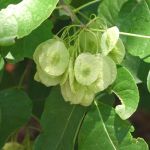| Common Name: |
Hop Tree |
| Other Names: |
Wafer Ash |
| Botanical Name: |
Ptelea trifoliata |
| Genus: |
Ptelea |
| Family: |
Rutaceae |
| Native Location: |
N America (Ontario to Florida, Texas, and N Mexico) |
| Cultivation: |
Moist, well-drained soil in sun or lightly dappled shade. |
| Propagation: |
By seed sown in autumn or spring (species only); by greenwood cuttings in early summer. |
| Harvest: |
Roots are lifted in autumn and peeled for bark, which is dried for use in infusions, and powders. |
| Height: |
7m (25ft) |
| Width: |
4m (12ft) |
| Variations: |
Aurea
Has yellow-green leaves that turn yellow in autumn.
Height: 5m (15ft) |
|
| Hardiness: |
Z4-10 |
| Parts Used: |
Root bark. |
| Properties: |
A bitter, pungent, tonic herb that lowers fever and improves digestion; it expels intestinal parasites, and has anti-bacterial effects. |
| Medicinal Uses: |
Internally for fevers (especially intermittent), heartburn, poor digestion, roundworms, and pinworms. Externally for wounds. |
| Bibliography: |
The Encyclopedia of Herbs by Deni Bown Copyright © 1995, 2001 Dorling Kindersley Limited. pg. 335 |
